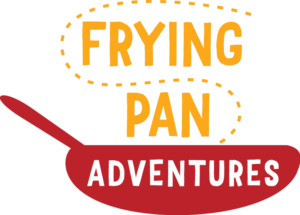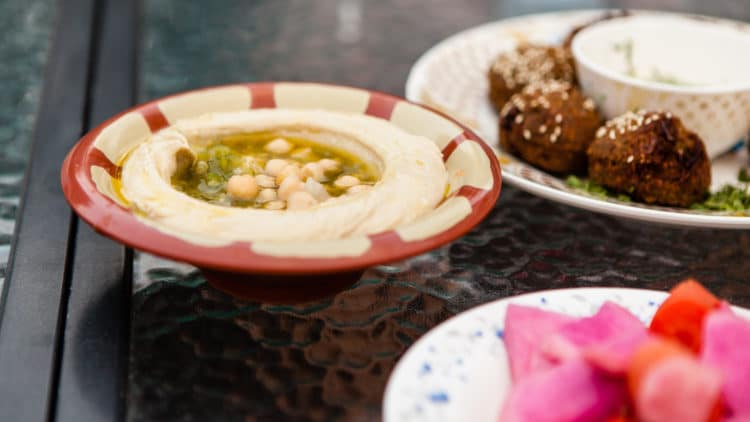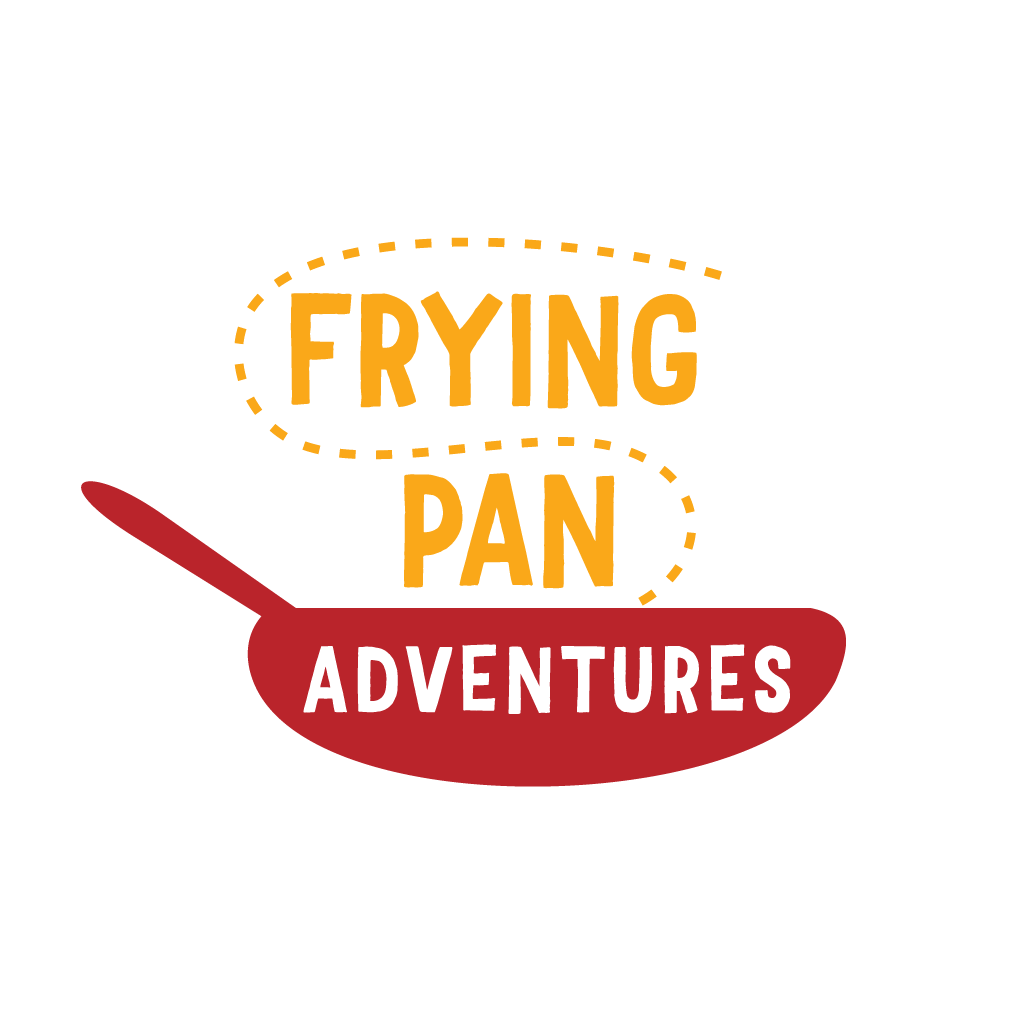Always wondered why your homemade hummus is never as creamy as restaurant-style hummus? Why does it always feel grainy and garlicky rather than luscious and balanced? Lebanese supper club host Lynn Hazim (@_nosoupforyou) shares her findings on our podcast based on a month-long series of experiments to create the perfect homemade hummus. She tested a number of variables, including canned vs. dried chickpeas, timing of soda bicarbonate, citric acid vs. lemon juice, ice cubes vs. none, cumin vs. none, type of oil, brands of chickpeas and tahini and more.
If you’re looking to up your hummus game at home, grab your notepad and start listening!
Quick summary:
Everything you need to know to make the perfect homemade hummus.
You can find Lynn’s perfect hummus recipe on her Instagram highlights here.
-
- If you have the time, use dried chickpeas for better flavour.
- After soaking and draining, sauté the chickpeas with bicarbonate of soda to get the chickpea skins to wear off. This should be done before you boil them.
- Adding ice while blending improves the texture and colour of the hummus.
- Tweak and fine-tune the recipe based on the quality of your ingredients. Different brands can give different results.
- Don’t add garlic especially if you plan to store hummus over a few days as the flavour intensifies.
- Use Toppings and mix-ins to add texture and flavour.
- Hummus means chickpeas and not spread/dip. If there aren’t any chickpeas in it, then it’s not a hummus!
Our favourite local spots for killer creamy hummus that won’t kill your wallet: Foul w Hummus in Barsha and Sultan Dubai Falafel in Deira.

Lynn Hazim aka @_nosoupforyou
Want more of our scrumptious podcast episodes? Feast on our main podcast page here!
Subscribe on: Apple Podcast App | Spotify (available on AppStore and Google Play) | Google Play Music (currently supported only for listeners in US/Canada) | Anghami
Not a fan of audio? Here’s the show transcript for you to read!
Arva: This show is brought to you by Dubai’s most gluttonous food tour company, Frying Pan Adventures, and you’re listening to Deep Fried.
Hey there, I’m your host, Arva Ahmed and thanks for joining me on the show that’s inspired by flavours of the East. This podcast celebrates the flavours that we as storytellers, content creators and food tour guides with Frying Pan Adventures have discovered in Dubai. Now the dish that we’re going to chat about today needs no introduction—it’s hummus—or more precisely, hummus-bil-tahina: chickpeas blended with sesame seed paste.
Now, while we’re pretty spoiled for choice in Dubai—there’s tons of fantastic hummus here across our Middle Eastern restaurants—what do you do if you don’t have high quality hummus at your doorstep? Well, our speaker today is going to help us ensure that if you ever find yourself in that compromised situation, you never have to resort to the supermarket or mass-made stuff.
We’ve brought in someone who’s created waves in the local community with her painstaking experiments to get to the super-perfect, creamy, restaurant-style hummus. Now, these experiments didn’t just come out of nowhere. This Lebanese lover-of-food has her own supper club in Dubai and if you look at her Instagram account, you know that she’s dead serious about her food.
I’m talking about the lovely Lynn Hazim or what most people know her as, her Instagram handle, @_nosoupforyou.
Lynn, I’m so delighted that you’re here to chat with me about hummus today.
Lynn: Same here, I’m super excited! Thanks for having me.
Arva: Well, I want us to just set the stage before we start talking about hummus. So you’ve done this whole series of experiments on how to make the perfect restaurant-style, uber-creamy, hummus. How long did all of those experiments take and actually what got you started? Like, what inspired you to take up this noble cause for the community?
Lynn: So this started at the very beginning of quarantine and working from home. I think probably the first week into it. I was so excited about working from home, I’m like, now’s the time to actually create all the recipes that I’ve never had time to create. So I had all of these different recipes saved on my YouTube channel, Instagram and so on. And I remember one of them was a trick to making a hummus-bil-tahini which I had never done at home.
Because as you said, hummus is so common in Dubai and you can find really good hummus in restaurants everywhere and I’m like, I really want to try hummus-bil-tahina. And I remember that my mom used to do it at home and it was never as perfect as in restaurants. And I’m like, how come hummus is the one thing that restaurants do better than Lebanese moms?
How come it’s that one thing that at home, you get it—like, it’s still delicious—but it’s grainy, it’s full of garlic, it’s much thicker?
Arva: I’m so glad you said that. It makes me feel so much better about my homemade hummus!
Lynn: Yeah, yeah, yeah. It’s across and I’m like either it’s the machine that they use in restaurants, or I don’t know what it is?
So I tried that one recipe that I had found on YouTube that had a trick and it wasn’t a recipe—it was a western recipe—it wasn’t by a Lebanese chef or an Arab chef or anything. And then obviously it was grainy, it was full of garlic. The garlic flavor develops over time so it becomes even more garlicky as the days go by.
Then I started my research and I realized that I barely found any recipes for a restaurant-style hummus. And it’s also because you don’t have a lot of, like—at least in Lebanon, when you go to Lebanese restaurants—you know the restaurant really well, but you don’t really recognize the chef behind the restaurant. It’s very restaurant-driven, brand-driven and not really chef-driven. So these chefs, they don’t really put their recipes out there. They’re not really online and so on. So I couldn’t really find much. And I’m like, okay, let me try to change a few things.
So I tried, because when I initially tried that recipe, it was with canned hummus. I’m like, let me try to soak the chickpeas and see if that makes any difference. And it didn’t really make much difference. And that’s when I started googling recipes, trying to see what’s out there on YouTube. I had to research in arabic which I don’t usually do. And then you get completely different results.
And I found so many different variables. Like, I found the super traditional chefs that were using super big machines, or I would find them using citric acid instead of lemon juice, or putting in olive oil, or no oil, or soaking the chickpeas and then mixing the chickpeas and then putting them in the fridge and then doing the hummus the next day.
And I’m like, I really don’t know which recipe to trust and to actually take as a recipe for hummus. So that’s when I had the whole diagram. I’m like, okay, since I’m at home anyway, and I’m super excited about cooking and trying all these different things, let me try to make this at home. And then when I get obsessive, I get really obsessive.
And then I’m like, okay, let me try with canned versus dry hummus and all of these different variables. And I thought I would, I thought it would take like a week or something. I think it took about a month, maybe, but let’s just say there were some breaks in between. Like, sometimes when I, kind of like my hummus tastes like shit and it’s not working well, I’m like, I need a break from hummus. I’m going to stop for like, a week, because I would think that I’ve made progress and then I try, like, the next iteration and then it’s completely shitty and I’m like, okay, I’m going to take a break. I don’t want to see or smell any hummus at home for a while. So it took around a month.
Arva: Have you eaten hummus since?
Lynn: I…
Arva: You can’t look at it ever again?
Lynn: I didn’t for a month and a half, but you can’t not eat hummus. Like when I order Lebanese food, when I cook Lebanese food—I haven’t made hummus since, that’s a fact—I’ve eaten hummus, but I haven’t made hummus since. Cause, honestly, you get super good…
Arva: Everyone else has made your hummus.
Lynn: I know! And that was the most surprising part for me. I’m like, I’m doing all of this and I’m sure no one will even do it, because the whole process takes three days: between soaking the chickpeas, and then boiling them for three hours, and then putting them in a food processor, and then waiting for the paste to actually get cold before you mix it again so that you adjust the taste. I’m like, no, one’s going to do this, especially in Dubai or in Beirut, when they can get really, really, good quality, quality hummus, but they did and that was super surprising for me, so!
Arva: That’s what quarantine does to people then?
Lynn: Yeah, yeah..!
Arva: They spend three days making hummus! And just to clarify, cause we’re, I’m sure many of us are sitting here thinking that you’re kind of doing this day in, day out. Cause it takes a lot of time, you know, to be really scientific about recipe testing, about isolating all the variables that you’ve mentioned.
But I know that when we spoke, you actually alluded to a full time job and you just said you were working from home. So you’re actually telling us that recipe testing and cooking is not your full time gig. So what is?
Lynn: It’s not, I work in tech. I work for Google and that’s my full time job. So I try to, I mean, that was the nice thing about working from home, is that I can get one or two hours in the morning to do something and then if a meeting gets canceled, I’m like, okay, time to soak my chickpeas and then I have a few hours afterwards. Actually, that’s one of the main reasons I managed to do things like this, because if that was before, I would never spend a full weekend at home to wait for my chickpeas to soak and then to get them boiling for three hours and so on.
But then you’re working from home, so you’re at home anyway. I soak them overnight, I boil them while I’m working and then they’re done in the afternoon when I’m done with work. So that really helped for recipe testing. But yeah, no, food is not my full time job, I wish it was, but it’s not.
Arva: Well, you’re still a wonder woman in a lot of our eyes..
Lynn: Thank you.
Arva: ..not just because juggling two lives, your tech life and your culinary life, but also because you’ve made this entire flow chart of hummus variables, which I saw on your instagram, you know, this flowchart to make the perfect hummus, and I just fell in love with that.It just made the food geek in me so happy.
So just briefly walk us through the variables on the chart, I mean, we’ll get into each of those variables in more detail later, but just list out the things that you test out.
Lynn: I have, I have, like, I resonate much more when things are visual and versus spoken.
So I’m trying to remember how it was, but I remember the variables were so based, so chickpeas first, should they be canned or should they be dry? And then after this, the methods of cooking the chickpeas, particularly, if they’re canned, should they be mixed with bicarbonate of soda during the soaking and during the cooking, or only during the soaking? Should they be scruffed with the bicarbonate of soda before cooking them and then adding the water, or should they just be boiled without anything? And then once that is scrapped, should you take off the skin or keep the skins? Or have the skin on?
And then once that is done is the order of mixing. So do you start mixing your chickpeas into a paste and then you add the tahini or the oil, lemon juice and everything, or do you start with tahini first, which was in some of the recipes.
And then once you get the orders straight, do you add ice cubes or is it just a myth that ice cubes actually make the hummus whiter and creamier? And then do you add oil or do you not add oil? And if it’s oil is an olive oil or is it a neutral oil?
I will say, as I’m saying this, I’m like, I can’t believe I went through all of this!
And then when it comes to—so one thing I noticed across actually, was that garlic is not used in restaurant-style hummus. And I’m like, why does everyone assume that you need to put garlic in? Like, hummus in restaurants does not taste garlicky, but it’s just, we’re so used to putting garlic in everything that we cook. So garlic, I never experimented with it.
But then, do I put citric acid or lemon juice? So citric acid is, if you’re not familiar with it, its lemon salt. It sounds super scientific, but it’s lemon in the form of salt, and what it does is that it actually helps preserve the hummus. If you’re keeping it in your fridge for more than a day, it doesn’t go bad, like lemon juice would and somehow it was like much..
Arva: That’s fascinating! Okay, because I have citric acid, I just call it lemon salt like you mentioned, in my pantry. And I just got it on a whim thinking that it sounded really cool and I was definitely going to use this, but it’s really strong.
Lynn: Yeah.
Arva: So you can’t just sprinkle it over things, it’s a burst of flavor, but this is so great to know that you can use this.
Lynn: Yeah, when I don’t feel like cutting a lemon wedge and choosing lemon over something, I just take mine, cause I have citric acid in the shaker. So I just sprinkle a bit of citric acid and then it feels like you squeezed some lemon juice over it and that’s perfect.
So that was part of the reason why I stick to citric acid versus lemon juice. It’s just a lot easier to manage. So as you were saying, it’s super intense. So I think in my whole hummus, I used one spoon of citric acid. And then I said that you can replace it with lemon juice, but then people would replace it one to one. So, they would just have one spoon of lemon juice instead of the citric acid and that’s not enough.
So I had all of these people sending me different messages: “I did it, but it wasn’t lemony enough, so what would you do?” So that also helped a lot in making the process simpler. Cause every time I would get questions about the process, it would make it simpler for me.
Arva: Crowd testing a recipe!
Lynn: Exactly. So these were, I’m thinking if there were more, I think that was pretty much.
Arva: Cumin, I think I remember seeing it on the chart, now.
Lynn: Yes, yes, yes, cumin.
So with cumin or without cumin? I think I went without cumin, at the end. You can add cumin on top. I mean, it would taste great with it, but you don’t need to add it inside.
And that was it. So the two constants were ice cubes, I think the one constant, was ice cubes actually. And then I decided, so I had all of these variables and then I’m like, let me just try it with dried chickpeas, because that’s what I saw online, that all the restaurants use.
And then once I have that recipe figured out, I’ll see if it works as well with canned chickpeas. Which, it does. It’s a lot faster. It takes 20 minutes to boil canned chickpeas. You just take them out of the can instead of soaking them overnight and then boiling them for three, four hours, but it doesn’t taste the same. It’s like a quick way to do it, but it doesn’t taste the same.
Arva: Okay. So if you don’t have three days to spend..
Lynn: Exactly.
Arva: ..that’s your go to. Okay. Well, I mean, for something that looks so deceptively simple..
Lynn: Right? Exactly.
Arva: ..there’s just so many variables and I’m really happy, that you..
Lynn: I forgot one extra variable was the brands, so the tahini brand, the chickpeas brand.
And sometimes, I wouldn’t know why when I was boiling the chickpeas for three hours, sometimes they were okay, sometimes they were undercooked, sometimes they were over cooked, sometimes they would turn brown.
And then actually, what was great is, because I was posting all of this on instagram. I have a few chefs who follow me and they were super nice because they were super helpful. They’re like maybe your chickpeas brand is not really good. Try to change this with this.
So they would give me a lot of tips, but what was happening was that it was the first week of quarantine; first, second, third week. And I don’t know if you remember, but ordering something online would take you, like a week to 10 days.
You want a specific brand, it’s not necessarily available or you think it’s available and then a week later they’re like, this is out of stock. So also controlling these variables was kind of out of control. I couldn’t really be like, no, this is the only brand that I want, but that made a huge difference in the output.
Arva: Wow! Okay, so I was gonna say that I’m really happy that you started off with the first variable being the chickpeas and I’m going to use that as an opportunity to just voice something that I feel super strongly about—and I know we discussed this when we were prepping for the podcast—which is, I mean, I know that hummus is now part of the global culinary lexicon, but I just want to put this thought out there in the world, that, if it doesn’t contain chickpeas, it cannot be a hummus.
Lynn: Exactly.
Arva: Is that a fair statement?
Lynn: It’s very fair. Yeah. I mean, hummus means chickpeas and then the spread is called hummus-bil-tahina, which is hummus with the tahini. So if it’s just a spread, then it’s not hummus.
Arva: Exactly, so the arabic word, the hummus, just literally means chickpea..
Lynn: Exactly.
Arva: ..like you said, it doesn’t mean a dip or spread or pureé or whatever else. But essentially when you look at all of these fusion things: beetroot, butternut, squash spread. If those don’t contain chickpeas, then let’s just call it something else?
Lynn: Exactly.
Arva: Just imagine if people started calling ketchup, mustard! You know? It’s that what-the-hell moment that folks in the Middle East probably have, every single time someone tries to claim that a guacamole lookalike is an avocado hummus.
Lynn: I agree.
Arva: Alright, so, rant over, I want us to get back on track to make the perfect hummus. But before we do that, let’s take a quick pause for our proud sponsors, Abela and Co.
Abela is the catering team that’s been preparing delicious meals since 1967. They bring over 53 years of food service experience and cater to a diverse range of sectors in the UAE, including corporates, healthcare facilities, hotel-staff catering, large industrial companies, educational institutions and private events.
Find them now at www.abelaandco.com.
..and we are back to chatting about the perfect, creamy, hummus on Deep Fried with supper club host and hummus authority, Lynn Hazim.
Alright, Lynn, now it’s kind of overwhelming because there’s all of these different variables and for someone who’s never made hummus before, they might kind of run away and say: “I’m not even going to start”. But if you had to prioritize for the person who has never done this before—you had to prioritize just three things that they should get right—what are those three things?
And I know you already began by saying that ice is non-negotiable. So why don’t you get us started there and then give us two more?
Lynn: So, first it doesn’t have to be that complicated because I did all of the testing, so you don’t have to test.
Arva: You don’t have to make it a million times, over a month.
Lynn: Exactly, and hopefully, it’ll be good. So I actually learned a lot by other people testing the hummus and telling me what worked, what didn’t work. I thought that restaurants do hummus-bil-tahina really well because, and it’s super smooth, because they have a super strong food processor and I have a super strong food processor at home so I thought that this helped me.
But then I had a lot of people who did the recipe, who were actually using a hand blender and it turned out super smooth, or they told me that their food processor is not strong enough and it was still super smooth. So the first week of doing hummus, I would have told you need a strong food processor, but not necessary.
Arva: That’s what I thought! I always say that. That’s exactly what I thought. Okay..
Lynn: So for..
Arva: ..so I’m really glad you’re giving us an option out. We don’t have to go out and invest in a thousand dollar machine.
Lynn: So the replacement for that; probably people thought that because they wouldn’t boil their chickpeas until they’re super smooth. But the replacement for that is, really, kind of over-boiling your chickpeas. Until when you take one out and you kind of crush it between your fingers, it just melts between your fingers, and taking the skin out.
And what I did in my recipe is that I kind of found a way to take the skin out without having to manually remove the skin out of every one. Which is basically when you scruff the hummus at first, you kind of sauté them with bicarbonate of soda and what it does is that they become very weird and mushy, and then you boil them.
So what happens is that the skin disintegrates and it’s just there in the water, and then once you’re about to drain the chickpeas, once they’re boiled, you kind of let the skin get out with the water. So you’re left with, let’s say, 30% skin which is fine. But I would say for super smooth, regardless of the food processor you have, you need to over-boil your chickpeas and take the skin out. That’s one.
Ice, as you said, it’s super important to make it white and even creamy and fluffy. I tried researching it and it’s, I don’t know, but it does work.
Arva: This might be the next month long project?
Lynn: It does work, it does make a difference.
Arva: So, I have not researched the chemistry behind this, but I’ve heard different chefs talk about this, including Suzanne Husseini, who’s based in Dubai. And some of the common threads I’ve heard is that the ice helps to A. Cool down the blender..
Lynn: Yeah, that’s true.
Arva: ..and secondly, it provides more abrasive material that helps to crush the chickpeas down to an even finer, smoother paste. So that might be a hypothesis, who knows? But, yes, for your next experiment maybe that’s the one to go down.
Lynn: Yeah, so, cooking your chickpeas properly, ice is super important. I’m thinking of the third thing that you cannot, not do. I guess it’s the ratio of ingredients and really doing it step by step.
So even if my recipe says, I don’t know, one kilo of chickpeas and one cup of Tahini and one spoon of citric acid it might be a bit different for you depending on the brand of chickpeas that you have, the brand of the tahini that you have.
So even after doing this 20 to 30 times, I would still put half of the ingredients in and then mix them all in and then add a bit more, a bit more and then put it in the fridge for three to four hours until it sets. Taste it again, see what it needs more and then add them gradually. So I think in order to get the right ratio of the tahini to lemon to chickpea paste. You really need to do it gradually until you get the right consistency.
Arva: That’s really interesting because people do get very funneled by a recipe, especially if it reads “The Perfect Restaurant-style, Hummus”, you’re not going to want to move. You’re not going to want to budge an inch from that.
Lynn: And I tried to—in my story, when I posted the last recipe—I tried to explain what every ingredient does.
So I tried to explain, the ice actually adds whiteness and creaminess. That, adding the tahini makes the paste thicker. So if you’re getting, if you’re hummus becomes too liquid-y because you’ve really overboiled your chickpeas, then just adding more tahini would thicken it up. The oil helps in emulsifying the hummus. That, letting it sit in the fridge, which will actually help develop the flavors and it’ll taste different.
So I try to explain what these variables do, so that when they do try it at home, they can kind of self-rely on themselves to understand, “okay, it’s not tasting as much, I don’t know, tahini as I want it to be”, or it’s super liquid-y and so on. And they would know by themselves what they need to do. But yeah, even after 30 tests, there’s no like one specific recipe that you can follow through the ingredients. You still need to use your judgment.
Arva: Very true. Now you alluded to scruffing the chickpea with soda, with bicarbonate soda. Can you just tell us a little bit more about that?
Lynn: What you do is that after soaking the chickpeas overnight with bicarbonate of soda, as well, you drain them and then you put them in a pot. You put a spoon of bicarbonate of soda, you put them on medium to high heat and then you just sauté them.
And you mix the bicarbonate of soda with the chickpeas and then you would start seeing the skin disintegrating from the chickpeas. And then you add your water, cold water, so that you start boiling your chickpeas.
And this is what actually helps in the skin disintegrating from the start. So that once, like, after they boiled for three hours, once you drain them, all of that skin is actually getting out with the water and you’re left with skinless chickpeas.
Arva: Alright.
So while I’m definitely opposed to having non-chickpea dips referred to as hummus, I do love my garnishes over hummus, I love mix-ins.
How do you like to dress your dip? And actually let’s begin with one of the variables that you mentioned earlier, which is the oil. Do you use that as a garnish? Are you actually blending it into the hummus?
Lynn: So blending it in? Yes, for sure. Olive oil as well. And then, I do put lots of olive oil on top, not just like a small drizzle, but I’m super generous with the oil.
And for me it needs to be olive oil from Lebanon, Palestine, Syria. One of these countries from the Levant, because it’s a completely different olive oil taste than the olive oil that you get from Italy, Spain, Greece and so on. Which is also super delicious, but it’s just completely, completely different.
It’s much more green and grassy and it just goes so much better with Lebanese food. So lots of olive oil, always. I add a bit of paprika or cayenne powder, but that’s just to make it look nicer and a bit more vibrant.
And then what happened is that because I was at home and I had all of that hummus—and I gave a lot of it to my neighbors, but I still had a lot of hummus at home—I started experimenting, and it was still full-on quarantine mode. So it was whatever I had at home. So I had a lot of toppings. I think I did one with a Sujuk, which is one of my favorite sausages.
Arva: Mmm..
Lynn: So sujuk in chilli oil on top of the hummus. I did one with chickpeas. So full chickpeas from a can, and then just mixed a bit with lemon juice, olive oil, coriander, a bit of onions and then you put them in the middle as well.
I did with ground meat and pine nuts, which is super popular in Lebanon as well. I would add just chili oil on top just to make it a bit chili. So garnishes, add-ons, it’s perfectly okay.
And even beetroot hummus—if it’s really a hummus that’s blended with beetroot—it can also be super delicious and that’s still hummus. It’s just a flavored hummus.
Arva: Fantastic! One of my favorite and very simple additions is one of the hummus that we have on our Middle Eastern Food Tour. So it’s at a Palestinian-Jordanian restaurant called Qwaider al Nabulsi and they splash in this vibrant-green, magical sauce, which we just call Tatbeeleh. And it’s a blend of green bell peppers, a few green chili peppers, lemon juice, heaps of garlic..
Lynn: Is it shatta?
Arva: Exactly, but it’s the green shatta and they blitz it together and they splash it over the hummus and it just kicks up all the flavors.
Lynn: Yeah, there’s a place in barsha called the Foul W Hummus and they actually have it with the green shatta.
Arva: So, this was super insightful. And as someone who enjoys making hummus at home, but it never lives up to the creamy restaurant-style one, you’ve just given me renewed hope. if people want to find you on instagram and see that wonderful series of hummus posts that you have on your highlights, where do they find you again?
Lynn: So, on Instagram, my handle is @_nosoupforyou and I have two highlights saved. One is for the whole experiment, so in case anyone is interested in seeing me fail, over and over, it’s there and then there’s the recipe that’s highlighted separately as well.
Arva: Awesome! Well, we’ll make sure to share the link to your profile and the hummus highlights in our show notes.
Lynn: Thank you!
Arva: And dear listener, I hope you enjoyed tuning in.
If you liked this show, please do rate, review and share it. And connect with us over social at Frying Pan Adventures on Instagram and Facebook and @FryingPanTours on Twitter.
And as always, before we head off, I want to leave you with these wise words from none other than the American inventor, himself, Thomas Edison: “I have not failed. I’ve just found 10,000 ways that won’t work.”

Arva Ahmed is the co-founder of Frying Pan Adventures, Dubai’s first food tour company, and a celebrated food explorer known for uncovering Dubai’s hidden culinary gems. Her expertise in the city’s diverse food scene has been featured in prominent publications such as CNN, Khaleej Times, BBC Travel, The Sun, The Independent and countless more. She also hosts Ditch the Silver on YouTube. Through her immersive tours and storytelling, Arva brings Dubai’s rich flavors and vibrant cultures to life.




